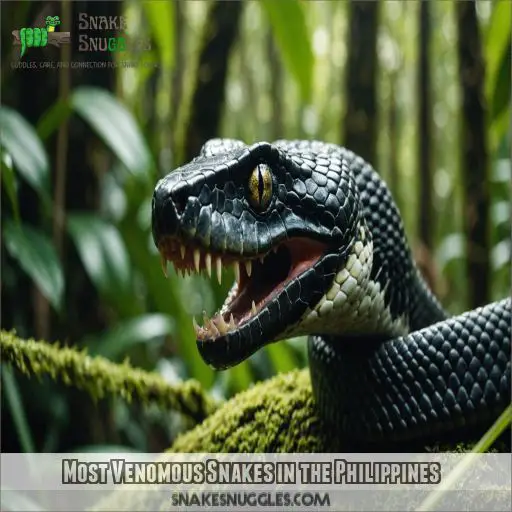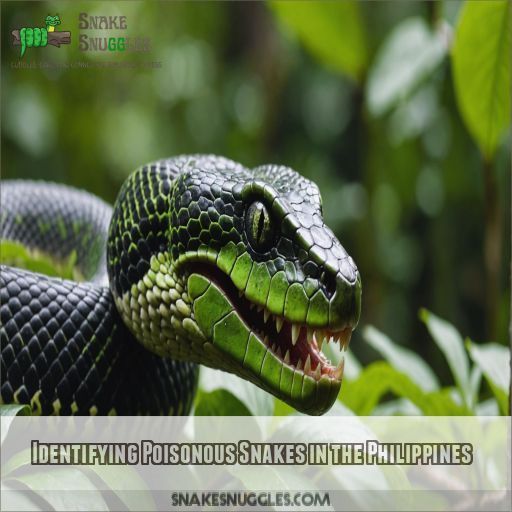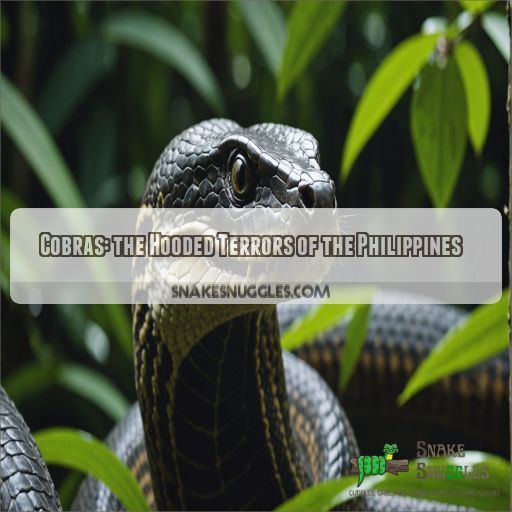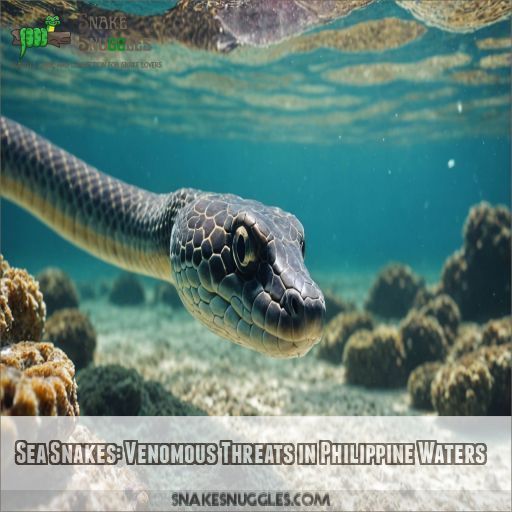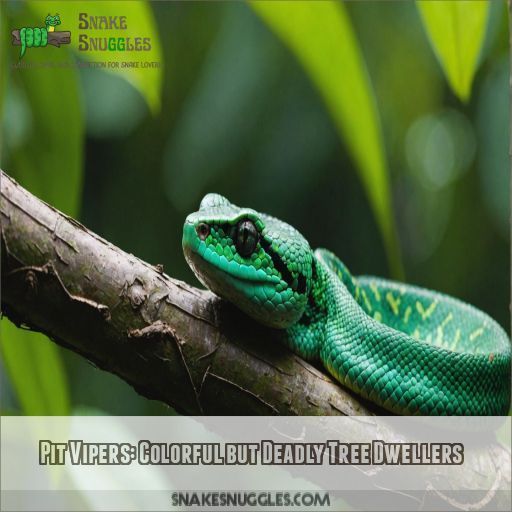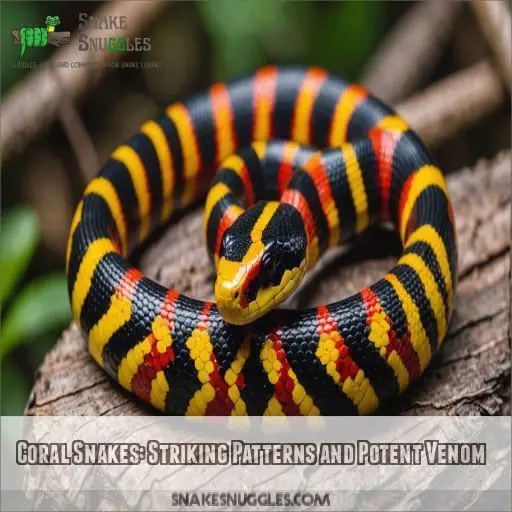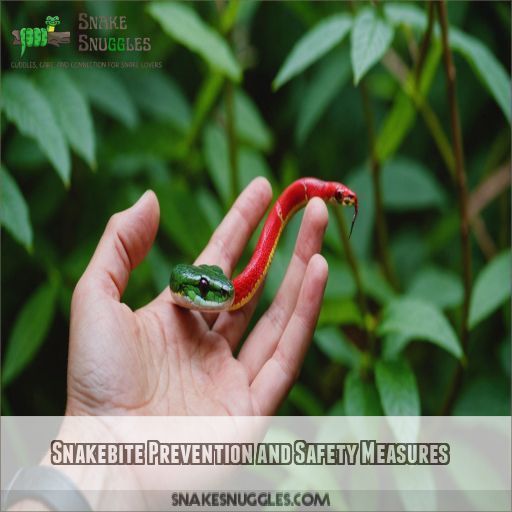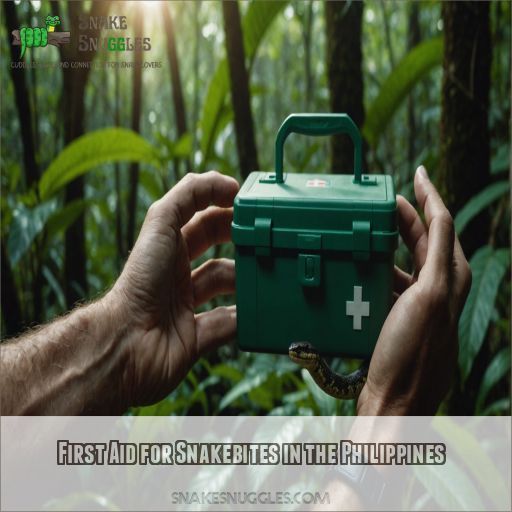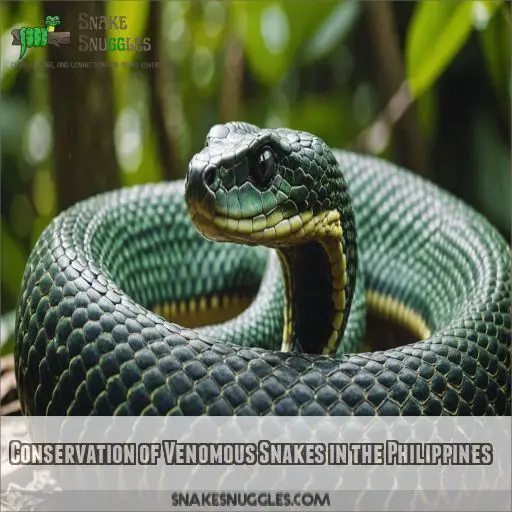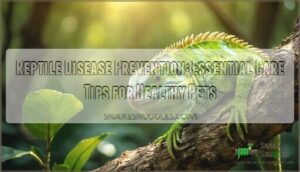This site is supported by our readers. We may earn a commission, at no cost to you, if you purchase through links.
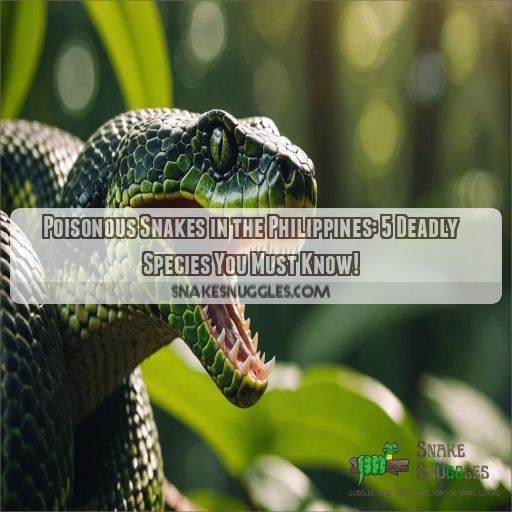 You’re about to enter the habitat of some of the world’s most venomous snakes – the Philippines, home to over 200 species of snakes, many of which can be deadly if not identified and treated promptly . Poisonous snakes in the Philippines are a real concern, with species like the King Cobra, Philippine Common Cobra, and Chinese Sea Krait packing potent venom . But don’t worry, with the right knowledge, you can minimize the risks. By learning about the physical characteristics, habitats, and behaviors of these snakes, you’ll be better equipped to avoid them and stay safe (Source). So, are you ready to meet the slithery residents of the Philippines?
You’re about to enter the habitat of some of the world’s most venomous snakes – the Philippines, home to over 200 species of snakes, many of which can be deadly if not identified and treated promptly . Poisonous snakes in the Philippines are a real concern, with species like the King Cobra, Philippine Common Cobra, and Chinese Sea Krait packing potent venom . But don’t worry, with the right knowledge, you can minimize the risks. By learning about the physical characteristics, habitats, and behaviors of these snakes, you’ll be better equipped to avoid them and stay safe (Source). So, are you ready to meet the slithery residents of the Philippines?
Table Of Contents
- Key Takeaways
- Most Venomous Snakes in the Philippines
- Identifying Poisonous Snakes in the Philippines
- Cobras: the Hooded Terrors of the Philippines
- Sea Snakes: Venomous Threats in Philippine Waters
- Pit Vipers: Colorful but Deadly Tree Dwellers
- Coral Snakes: Striking Patterns and Potent Venom
- Snakebite Prevention and Safety Measures
- First Aid for Snakebites in the Philippines
- Antivenom Availability and Treatment Centers
- Conservation of Venomous Snakes in the Philippines
- Frequently Asked Questions (FAQs)
- What is the most venomous snake in the Philippines?
- Are snakes in the Philippines dangerous?
- Is the black house snake in the Philippines poisonous?
- Do king cobras live in the Philippines?
- What should I wear when exploring areas with poisonous snakes?
- How do I safely remove a poisonous snake from my home?
- What are the symptoms of a poisonous snakebite in humans?
- Can poisonous snakes in the Philippines be found in urban areas?
- How do I protect my pets from poisonous snakes in Philippines?
- Conclusion
Key Takeaways
- You’ll want to watch your step in the Philippines, home to over 200 species of snakes, many of which can be deadly if not identified and treated promptly. Don’t worry, with the right knowledge, you can minimize the risks and appreciate these slithery residents from a safe distance.
- When exploring the great outdoors in the Philippines, gear up with the right attire to minimize snake encounters. Wear hiking boots, snake-proof pants, and clothes with bright colors to increase visibility, and avoid tall grass and dense vegetation where snakes may hide.
- If you’re unlucky enough to get bitten, staying calm and following the proper first aid procedures can really help your chances of a speedy recovery. Immobilize the affected limb, remove any jewelry that may constrict due to swelling, and seek medical help as soon as possible.
- By understanding the ecological role of Venomous Snakes and the threats they face, you can contribute to their conservation and help maintain the balance of the Philippines’ rich ecosystem. Respect their space, and they’ll spare your life.
Most Venomous Snakes in the Philippines
You might think all snakes are scary, but in the Philippines, these five species take the cake for deadliness. From the majestic King Cobra to the sneaky sea snakes, let’s get to know the most venomous serpents slithering through the archipelago’s jungles and waters.
King Cobra (Ophiophagus Hannah)
You’ve probably heard of the king cobra.
Did you know it’s the longest venomous snake in the Philippines?
These impressive creatures can grow up to 18 feet long!
With their olive-green bodies and distinctive black-and-white bands, they’re hard to miss.
While they’re not typically aggressive, their venom packs a punch.
If you spot one, keep your distance and admire from afar!
Philippine Common Cobra (Naja Philippinensis)
You’ll want to keep an eye out for the Philippine Common Cobra, a true local celebrity in the venomous snake world. This slithery neighbor packs a punch with its potent venom, so it’s best to steer clear. Here’s what you need to know about this hooded troublemaker:
- Sports a sleek, yellowish-brown to dark brown coat
- Rocks a distinctive black and white "necklace" pattern
- Can spread its hood wider than your dinner plate when feeling feisty
- Prefers hanging out in lowland areas, from forests to rice fields
- Hunts both day and night, snacking on small mammals and other snakes
Chinese Sea Krait (Laticauda Semifasciata)
You’ll want to keep an eye out for the Chinese Sea Krait when swimming in Philippine waters.
This striking snake, with its black and silvery bands, packs a powerful punch.
Its venom is no joke – twice as potent as many land snakes!
While they’re generally docile, it’s best to give these underwater serpents a wide berth.
Common Sea Snake (Enhydrina Schistosa)
You might think sea snakes are just aquatic noodles, but the common sea snake packs a serious punch! Found in Philippine waters, these slippery customers are no joke. Here’s what you need to know:
- Their venom is twice as potent as many land snakes
- They can dive up to 100 meters deep
- They primarily feed on fish and eels
- Despite their deadly bite, they’re generally not aggressive
Wagler’s Pit Viper (Tropidolaemus Wagleri)
Moving from sea to land, let’s slither into the world of Wagler’s Pit Viper.
This tree-dwelling serpent is a master of camouflage, blending in with its lush surroundings.
Don’t let its beauty fool you, though; its venom packs a punch!
While not as lethal as the king cobra, a bite from this pit viper can still ruin your day.
Keep your eyes peeled in the forests!
Identifying Poisonous Snakes in the Philippines
You’re about to dive into a crash course in Philippine snake identification, so get ready to become a reptile-spotting pro! By learning the telltale signs of the country’s most venomous serpents, you’ll be better equipped to stay safe and appreciate these fascinating creatures from a respectful distance.
Physical Characteristics and Markings
If you’re trying to spot poisonous snakes in the Philippines, here’s what to look for:
- Distinctive head shapes (triangular or arrow-shaped)
- Vivid patterns or bands (think nature’s warning labels)
- Unique scale arrangements (especially on the head)
- Striking eye colors or shapes (like cat-like pupils)
Habitat and Geographic Distribution
Now that you can spot these deadly snakes, let’s talk about where they hang out.
You’ll find these venomous villains across various elevations and climates in the Philippines.
From the lush rainforests to the coastal areas, each species has its preferred stomping grounds.
The country’s rich biodiversity means you might encounter endemic species unique to certain islands.
Human impact has pushed some snakes closer to urban areas, so keep your eyes peeled!
Behavior and Defensive Mechanisms
When it comes to behavior, these slithery creatures have some tricks up their sleeves.
You’ll want to keep an eye out for defensive postures like the cobra’s famous hood-spreading or a pit viper’s coiled stance.
Some snakes use mimicry or camouflage to blend in, while others might give you a warning rattle or hiss.
Common Misidentifications
Some snakes are easy to identify as dangerous, while others blend in with their surroundings.
You might mistake a harmless rat snake for a deadly coral snake, or confuse a whip snake with a viper.
Even seasoned hikers can mix up sea snakes and eels!
And let’s not get started on the python vs. boa debate.
Cobras: the Hooded Terrors of the Philippines
You’ve probably heard of cobras, those iconic hooded snakes that strike fear into the hearts of many. In the Philippines, these serpentine terrors come in several varieties, each with its own set of impressive and potentially deadly abilities that’ll make you think twice before venturing into their territory unprepared.
King Cobra Behavior and Habitat
Now, let’s get to know the King Cobra, the heavyweight champ of Philippine snakes. These hooded heavyweights aren’t just big; they’re brainy too. Here’s what you need to know:
- They’re picky eaters, dining almost exclusively on other snakes.
- Mama cobras are fiercely protective, guarding their nests for months.
- They’re not looking for trouble, but when threatened, they’ll stand their ground.
Spitting Cobras and Their Unique Defenses
While king cobras are impressive, you’ll find their spitting cousins equally fascinating. These sharp-shooters have evolved a unique defense mechanism that’ll make your jaw drop. They can accurately spray venom up to 10 feet away, aiming for the eyes of potential threats. It’s like having a built-in pepper spray!
| Spitting Cobra Species | Max Spitting Distance | Venom Accuracy | Primary Target |
|---|---|---|---|
| Northern Philippine | 8 feet | High | Eyes |
| Southeastern Philippine | 10 feet | Very High | Eyes |
| Equatorial | 9 feet | High | Eyes |
| Indochinese | 6 feet | Moderate | Eyes |
Philippine Cobra Venom Potency
The Philippine cobra is a venomous snake, related to the spitting cobra.
Its venom is potent and can quickly affect your nervous system.
A bite from a Philippine cobra can cause serious problems within 30 minutes if left untreated.
However, with quick action and proper medical care, you have a good chance of survival.
Cobra Conservation Status
While cobra venom packs a punch, these snakes face their own threats. Conservation efforts are super important to protect these hooded guardians. Here’s what you should know:
- Habitat loss is shrinking cobra populations faster than you can say "snake!"
- Captive breeding programs are giving cobras a fighting chance.
- Community involvement is key to changing hearts and minds about these misunderstood creatures.
Sea Snakes: Venomous Threats in Philippine Waters
You might think the ocean is a safe haven from venomous snakes, but think again! The Philippine waters are home to some of the world’s most dangerous sea snakes, including the lethal Chinese Sea Krait and the highly venomous Common Sea Snake.
Chinese Sea Krait Identification
| Feature | Description |
|---|---|
| Body | Thick, cylindrical |
| Coloration | Black bands on silvery background |
| Head | Small, with yellow snout |
Common Sea Snake Habitat and Behavior
While the Chinese Sea Krait prefers coastal waters, the Common Sea Snake takes it up a notch.
You’ll find these slippery swimmers in deeper Philippine waters, often hanging out near coral reefs.
They’re like underwater acrobats, diving up to 100 meters deep!
These sea snakes have adapted to freshwater too, with some even calling lakes home.
Just remember, they’re not looking for trouble, but it’s best to admire from afar.
Sea Snake Venom Characteristics
Now, let’s talk about the venom these slithery sea dwellers pack. Sea snake venom is no joke – it’s a potent cocktail designed to immobilize prey and defend against threats. Here’s what you need to know:
- It’s up to 10 times more potent than a rattlesnake’s venom
- A single drop can cause paralysis within minutes
- It attacks your nervous system like a lightning strike
- Your blood cells might burst like water balloons
- Antivenom exists, but it’s a race against time
Risks to Fishermen and Swimmers
You might think a dip in Philippine waters is all fun and games, but watch out!
Sea snakes are sneaky swimmers who can turn your beach day into a real pain in the neck.
For fishermen, these slippery customers can hide in nets or catch baskets, ready to deliver a nasty surprise.
Don’t panic, though!
With the right know-how and safety gear, you can keep these venomous voyagers at bay.
Pit Vipers: Colorful but Deadly Tree Dwellers
You might think those vibrant snakes in the trees are harmless, but don’t be fooled by their beauty. The Philippines is home to several species of pit vipers, including the Wagler’s pit viper, that pack a venomous punch despite their stunning colors and arboreal lifestyle.
Wagler’s Pit Viper Characteristics
Now, let’s turn our attention to a colorful character in the Philippine snake world: Wagler’s pit viper.
You might think these snakes are all bark and no bite, but don’t be fooled by their stunning appearance!
With their vibrant green scales and red-tipped tails, they’re like the Christmas trees of the snake world.
But make no mistake, their venom packs a serious punch.
Philippine Pit Viper Species Diversity
You might be surprised to learn that the Philippines is home to several pit viper species, each with its own unique flair. These tree-dwelling serpents are like nature’s jewels, but with a deadly twist. Let’s take a quick look at the diversity of these fascinating creatures:
- Wagler’s Pit Viper: The most common and widely distributed
- Philippine Pit Viper: Endemic to the archipelago
- Polillo Island Pit Viper: A rare gem found only on Polillo Island
Pit Viper Venom Effects
Now that you’re familiar with the diverse pit viper species in the Philippines, let’s talk about their venom. Pit viper venom packs a punch, causing some nasty effects on your body. Here’s a quick rundown:
| Effect | Description | Severity |
|---|---|---|
| Hemolytic | Destroys red blood cells | High |
| Coagulopathic | Disrupts blood clotting | Severe |
| Cytotoxic | Damages tissue and cells | Moderate |
Arboreal Habitat and Hunting Techniques
You’ll find pit vipers lounging in the treetops, masters of arboreal camouflage.
These sneaky serpents have climbing adaptations that would make Spider-Man jealous!
They’re patient hunters, waiting for unsuspecting prey to wander by.
When dinner arrives, they strike with lightning speed, delivering a potent venom cocktail.
Some species are night owls, while others prefer daytime hunting.
Either way, they’re the ultimate tree-dwelling predators of the Philippines!
Coral Snakes: Striking Patterns and Potent Venom
You might be fascinated by the striking patterns of coral snakes, but beware – their potent venom is a serious threat. In the Philippines, you’ll encounter species like the Palawan long-glanded coral snake and the Luzon coral snake, which are nocturnal, venomous, and prefer habitats like scrub jungles and monsoon forests .
Palawan Long-glanded Coral Snake
Now that we’ve explored pit vipers, let’s talk about the Palawan Long-glanded Coral Snake. Found only in Palawan, this venomous snake‘s striking pattern is a warning sign. Its venom can cause respiratory failure, so it’s really important to exercise caution. Remember, respecting their habitat is key to coexisting with these incredible creatures.
Luzon Coral Snake Identification
When exploring the Philippines, you might encounter the Luzon coral snake, identified by its striking color patterns of red, yellow, and black bands. Found in scrub jungles and monsoon forests, this nocturnal snake is relatively docile and avoids human contact. Be aware of your surroundings, especially at night, and respect its habitat to minimize the risk of an encounter.
Coral Snake Venom Toxicity
You might be wondering, just how toxic is coral snake venom? Coral snake venom is a potent neurotoxin that can cause respiratory failure, cardiac arrest, and renal failure. Treatment protocols often involve administering antivenom, which has proven effective in neutralizing the venom. Coral snake venom has evolved to immobilize its prey quickly, making it a formidable hunting tool.
Nocturnal Behavior and Habitat Preferences
You’re about to meet the coral snakes, nocturnal hunters that thrive in the Philippines’ scrub jungles and monsoon forests . These snakes adapt to darkness with specialized sensory adaptations, avoiding predators while searching for food . Their nocturnal hunting strategies are key to survival, with seasonal shifts in activity to optimize food sources (Source).
Snakebite Prevention and Safety Measures
You’re about to venture into the great outdoors in the Philippines, where snakes are an inevitable part of the landscape.
So you need to take snakebite prevention and safety measures seriously to avoid becoming an unwitting participant in a potentially deadly encounter.
Proper Footwear and Clothing
When exploring the Philippines’ great outdoors, gear up with the right attire to minimize snake encounters. Wear:
- Hiking boots with good ankle protection to prevent snakebites
- Snake-proof pants, like those made from thick, woven material
- Clothes with bright colors to increase visibility, especially in low-light weather conditions
Avoiding Snake Habitats
When exploring the great outdoors in the Philippines, you should avoid snake habitats to minimize the risk of encounters. Before heading out, research the area and stay on marked trails. Wear protective clothing, including long pants and closed-toe shoes.
| Habitat | Snake Species | Safety Tips |
|---|---|---|
| Forests | Cobras, Pit Vipers | Stay on marked trails, avoid tall grass |
| Grasslands | Coral Snakes, Rat Snakes | Wear long pants, closed-toe shoes |
| Rocky Areas | Sea Snakes, Kraits | Be cautious near rocky crevices |
| Backyards | Various species | Keep yards clean, remove debris |
Proper Reaction to Snake Encounters
When you encounter a snake, keep a respectful distance and stay calm. Avoid provocation, as this can lead to an attack. Back away slowly and seek shelter in a nearby building or vehicle. Inform authorities or a professional snake handler if the snake is venomous or in a populated area (Source). Prioritize caution and safety above all else.
Snake-proofing Homes and Gardens
You’ve learned how to react to snake encounters, now let’s snake-proof your home and garden. Start with fence barriers and snake-proof landscaping to prevent unwanted slithery guests. Remove clutter, seal holes, and use natural repellents like mint or basil. Move bird feeders away from your home, and store firewood and debris in sealed containers.
First Aid for Snakebites in the Philippines
When you’re exploring the great outdoors in the Philippines, it’s important to know what to do in case of a snakebite. If you’re unlucky enough to get bitten, staying calm and following the proper first aid procedures can really help your chances of a speedy recovery, so let’s get started on the basics of snakebite first aid in the Philippines.
Immediate Actions After a Bite
Stay calm if you’re bitten – panic can worsen the situation. Here are your immediate actions:
- Immobilize the affected limb to prevent venom spread
- Remove any jewelry that may constrict due to swelling
- Seek medical help ASAP – antivenom and treatment are vital
- Keep the wound below heart level to slow venom flow
- Don’t attempt to suck out the venom – it’s not effective and can cause harm
Do’s and Don’ts of Snakebite Treatment
Now that you know what to do immediately after a snakebite, let’s debunk some myths and discuss the do’s and don’ts of snakebite treatment.
| DO | DON’T |
|---|---|
| Remain calm and still | Try to suck out the venom |
| Immobilize the affected area | Apply a tourniquet or pressure bandage |
| Seek medical attention ASAP | Use home remedies or wait for symptoms |
Symptoms of Venomous Snakebites
Now that you know the do’s and don’ts of snakebite treatment, let’s talk symptoms. If you’re bitten, watch for pain, swelling, and nausea. Breathing difficulty and paralysis can also occur. Your body might feel like it’s on fire, but try to remain calm. These symptoms can progress rapidly, so it’s really important to act fast and get the right help.
When to Seek Medical Attention
If you’re bitten, don’t panic! Seek medical attention immediately if you experience severe pain, swelling, or difficulty breathing. Even if symptoms seem mild, it’s really important to get checked out. Remember, prompt treatment can be the difference between life and death. Don’t take any chances – get to a hospital ASAP and ask about antivenom access.
Antivenom Availability and Treatment Centers
You’re now familiar with the venomous snakes in the Philippines, but do you know what to do if you get bitten? In this section, we’ll walk you through the availability of antivenom and treatment centers in the country, because knowing where to get help is just as important as knowing how to avoid these slithery creatures.
Types of Antivenom in the Philippines
You’re bitten by a snake in the Philippines – what’s next? Fortunately, antivenom is available, but types and efficacy vary. The country produces its own antivenom, like the Philippine Cobra Antivenom, but research is ongoing to improve efficacy and accessibility. Be prepared for varying costs, and know that access might be limited in rural areas.
Major Snakebite Treatment Facilities
You’re bitten by a venomous snake in the Philippines – what do you do? Get to a major snakebite treatment facility ASAP! These centers have antivenom and expert care to increase your chances of recovery. Here are four key facilities to know:
-
- Research Institute for Tropical Medicine (RITM): Located in Muntinlupa, Metro Manila, RITM is a top destination for snakebite treatment.
-
- Philippine General Hospital (PGH): As a major teaching hospital in Manila, PGH has a dedicated toxicology unit for snakebite cases.
-
- Davao Regional Medical Center (DRMC): Located in Davao City, DRMC serves as a referral center for snakebite patients in the southern Philippines.
-
- Vicente Sotto Memorial Medical Center (VSMMC): In Cebu City, VSMMC has a poison control unit that handles snakebite emergencies.
Challenges in Antivenom Distribution
You’re probably wondering, what’s the challenge in getting antivenom to those who need it? Well, it’s a mix of cost, accessibility, storage, and logistics. Antivenom is expensive and hard to store, especially in rural areas . Awareness is also key – many people don’t know where to get antivenom or how to administer it .
Importance of Proper Species Identification
Getting the right snake species ID is super important when it comes to antivenom. If you get it wrong, the treatment mightn’t work, and that could be dangerous. Don’t just guess – get a pro to ID the snake. It’s a big deal. Accurate identification means the right antivenom is used, which gives you a better chance of getting better.
Conservation of Venomous Snakes in the Philippines
As you learn about the poisonous snakes in the Philippines, you’ll also discover the importance of conserving these species and their habitats. By understanding the ecological role of venomous snakes and the threats they face, you can contribute to their conservation and help maintain the balance of the Philippines’ rich ecosystem.
Ecological Importance of Venomous Snakes
As you explore the Philippines, remember that venomous snakes play a key role in maintaining the delicate balance of the ecosystem. They regulate prey populations, maintaining the health of crops and forests. By appreciating these snakes, you’re supporting biodiversity and the many benefits it brings.
- Predator-prey balance: Snakes keep populations in check, preventing any one species from dominating.
- Ecosystem services: Snakes contribute to nutrient cycling and seed dispersal.
- Venom applications: Venom has led to breakthroughs in medicine, like pain relief and cancer treatment.
Threats to Snake Populations
You might be surprised to learn that venomous snakes in the Philippines face numerous threats. Habitat loss and poaching top the list, but climate change, pollution, and disease also take a toll. As a result, many species are declining in numbers, making conservation efforts a pressing concern. It’s time to take action and protect these fascinating creatures!
Conservation Efforts and Protected Areas
You’re invested in snake conservation! Efforts are underway to protect venomous species in the Philippines. Snake sanctuaries are being established, and habitat restoration is ongoing. Local communities play a key role in conservation, but funding challenges persist.
- Snake sanctuaries provide a safe haven for venomous species to thrive.
- Habitat restoration helps maintain ecological balance.
- Local communities can support conservation by reporting snake sightings.
Public Education and Awareness Programs
You play a key role in venomous snake conservation through public education and awareness programs. Community outreach, snake safety training, and school programs help dispel myths and promote coexistence. Awareness campaigns, like wildlife conservation workshops, empower you to make a difference. By learning about these amazing creatures, you’ll become a champion for their preservation and your own safety.
Frequently Asked Questions (FAQs)
What is the most venomous snake in the Philippines?
You’re wondering about the most venomous snake in the Philippines? Well, that title belongs to the King Cobra, whose potent venom can cause excruciating pain, paralysis, and death within 30 minutes if left untreated.
Are snakes in the Philippines dangerous?
When exploring the Philippines, you’ll encounter various snake species, some venomous, others harmless. To stay safe, be aware of your surroundings, keep a respectful distance, and follow snake safety tips to minimize risks.
Is the black house snake in the Philippines poisonous?
Don’t panic! While black house snakes in the Philippines might look intimidating, they’re actually harmless to humans. These non-venomous snakes are more like unwanted houseguests, helping to control pest populations, so no need to worry!
Do king cobras live in the Philippines?
You’re wondering about king cobras in the Philippines? Yes, they do live there! As the world’s longest venomous snake, king cobras can grow up to 18 feet long and are found in the country’s forests and grasslands .
What should I wear when exploring areas with poisonous snakes?
When exploring snake habitats, wear closed-toe shoes, long pants, and consider long-sleeved shirts to minimize exposed skin – it’s always better to be safe than sorry, especially when slithery creatures are involved!
How do I safely remove a poisonous snake from my home?
When in Rome, don’t try to be a gladiator – leave snake removal to the pros! If you must, wear protective gear, use a long-handled tool, and slowly guide the snake into a secure container, keeping a safe distance.
What are the symptoms of a poisonous snakebite in humans?
If you’re bitten by a poisonous snake, you may experience pain, swelling, bruising, and blistering around the bite area, as well as systemic symptoms like nausea, vomiting, dizziness, and difficulty breathing – seek medical help immediately!
Can poisonous snakes in the Philippines be found in urban areas?
You might be surprised to find poisonous snakes in urban areas of the Philippines, but yes, they can be there! The Equatorial Spitting Cobra, for instance, has made its home in city regions with lots of greenery .
How do I protect my pets from poisonous snakes in Philippines?
A stitch in time saves nine," and that’s especially true when talking about protecting your pets from the venomous snakes of the Philippines. Here’s a quick guide to help keep your furry friends safe:
- Know Your Surroundings: Be aware of the types of snakes in your area. The Philippines is home to deadly species like the King Cobra, Yellow-lipped Sea Krait, and Equatorial Spitting Cobra.
- Keep Pets Away from Snake Habitats: Snakes like tall grass, vegetation, and water sources. Avoid letting your pets roam in these areas unsupervised.
- Secure Your Living Space: Inspect your home for small cracks or holes that snakes can use to enter. Seal these openings to prevent unwanted slithering guests.
- Be Vigilant During Walks: When walking your pets, stay on designated paths and avoid tall grass or dense vegetation where snakes may hide.
- Train Your Pets: Teach your pets to avoid snakes. Use positive reinforcement to train them to stay away from snake-infested areas.
- Seek Veterinary Advice: Consult a veterinarian for specific advice on protecting your pet from snakes, especially if you live in a high-risk area.
Conclusion
Exploring the Philippines’ lush landscape is like solving a puzzle, where every step reveals a new, potentially deadly, piece – poisonous snakes in the Philippines.
Now that you’ve met the infamous five, you’re better equipped to avoid their venomous fangs.
By understanding their habitats, behaviors, and characteristics, you’ll minimize the risks and appreciate these slithery residents from a safe distance.
Respect their space, and they’ll spare your life.

